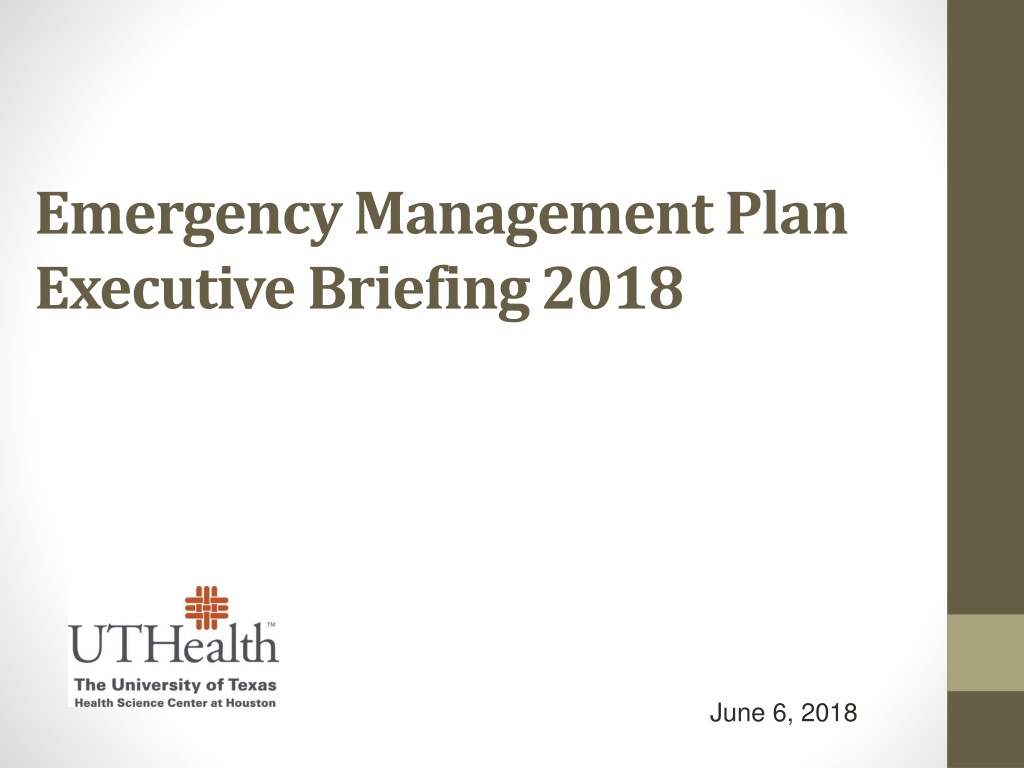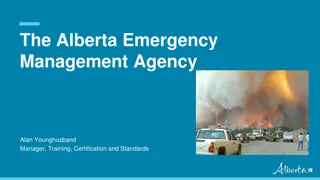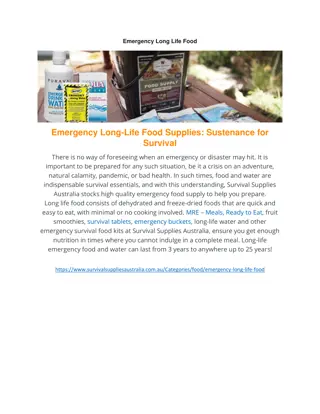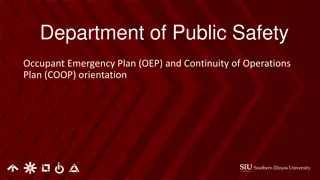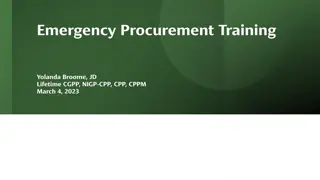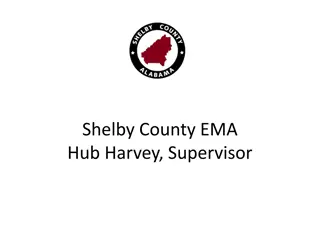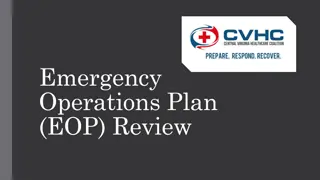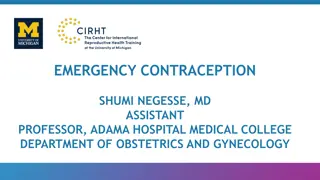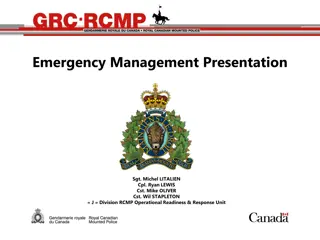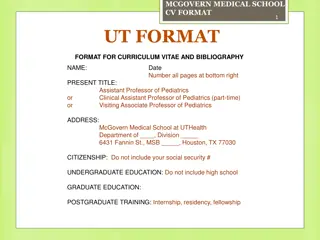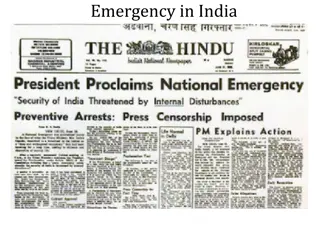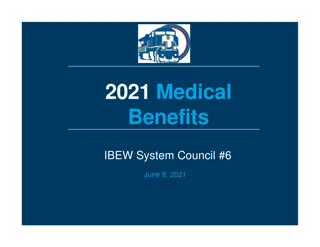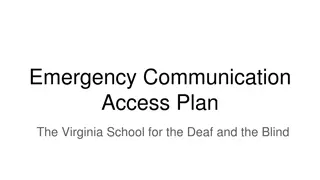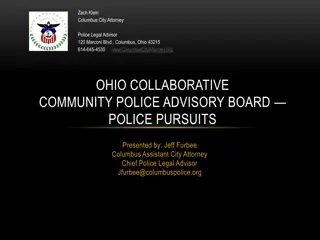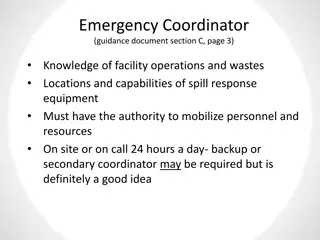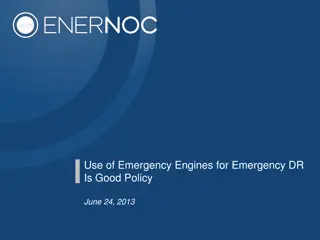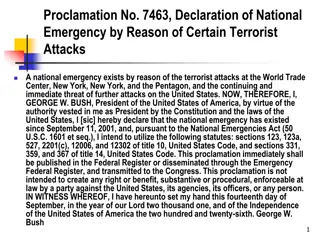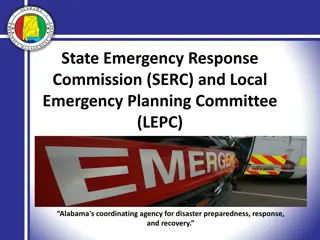Comprehensive Overview of Emergency Management Plan at UTHealth
This executive briefing outlines the emergency management plan (EMP) at UTHealth, focusing on its alignment with the National Incident Management System (NIMS). It covers major EMP elements, examples based on risk assessment (bomb threat and inclement weather), business continuity plan, NIMS requirements, and emergency management scope including prevention, preparedness, response, and recovery strategies. Key units involved with EMP and specific plan elements are also discussed.
Download Presentation

Please find below an Image/Link to download the presentation.
The content on the website is provided AS IS for your information and personal use only. It may not be sold, licensed, or shared on other websites without obtaining consent from the author. Download presentation by click this link. If you encounter any issues during the download, it is possible that the publisher has removed the file from their server.
E N D
Presentation Transcript
Emergency Management Plan Executive Briefing 2018 June 6, 2018
Overview UTHealth EMP congruency with National Incident Management System (NIMS) Brief description of major EMP elements Two Examples (based on risk assessment) Bomb threat Inclement weather (Hurricane/Flooding) Business Continuity Plan
National Incident Management System (NIMS) NIMS Federally required comprehensive national approach, applicable at all jurisdictional levels and across functional disciplines for responding to emergencies NIMS training required for emergency responders and emergency management team (you) NIMS required training is online Courses: IS 700.a, 100.HE, 200.b, 800.b http://training.fema.gov/IS/NIMS.asp
Emergency Management Scope Prevention Preparedness Response Recovery
Prevention Routine surveillance Lab, facility, and environmental safety surveys System testing Fire alarm and suppression systems, emergency generators, flood doors Safety training Lab safety training, Area Safety Liaisons, Facilities and Auxiliary Enterprises maintenance staff
Preparedness Communication Updated contact information Institutional Awareness and Education Emergency preparedness fliers UTHealth website Home preparedness kits Drills Fire drills Flood door drill (May 5, 2018) Hazardous material spill drills Tabletop exercises
Key Units Involved with EMP Environmental Health & Safety EMP development, testing, emergency response for health and safety, training Facilities, Planning & Engineering and Auxiliary Enterprises Monitoring advisories, protecting property UT Police Monitoring advisories, initial emergency notifications, crowd and access controls Public Affairs Institutional and external communications Information Technology Computer systems
Emergency Management Plan Elements Classified into levels for actions and notifications Level 1 (area) Level 2 (floor) Level 3 (building) Types of emergencies Inclement weather Fire Hazardous material releases / theft Facility failure Bomb, cyber/terroristic threats of violence Armed intruder Auto accidents Medical emergencies
FPEs Work Control Monitors Potential Emergency Situations & Informs VP FPE, and Answering Service UTPD Monitors Potential Emergency Situations & Alerts FPE s Work Control Emergency Notification If after hours: Answering Service Relays emergency event message OPA Environmental Health & Safety Reports to the scene of an emergency, assist as required CLAMC Coordinates the needs of the University s research animals UT Physicians Coordinates UTP Personnel & Updates the Executive Team VP of AE Coordinates AE Personnel & Updates the Executive Team VP of FPE Coordinates FPE Personnel & Updates the Executive Team Communications Updates information resources & informs the Executive Team as necessary Activate emergency advisorieson Web homepage Update voice mail message at 713-500-9996 or 713-500-7999 Notify School Deans and Executive Council as appropriate Notify answering service for main switch board Notify/Update News Media The decision to modify operations can be made by any of these individuals Dr. Robert Emery VP Environmental Health Safety and Risk Management Dr. Michael Blackburn Executive Vice President Research Kevin Dillon Sr Executive Vice President, Chief Operatingand Financial Officer Dr. Giuseppe Colasurdo President Wes Stewart VP of Facilities, Planning, & Engineering Chief William Adcox UTPD Chief of Police
Emergency Communication Options UTHealthALERT text messages for imminent threats UTHealth intranet emergency banner Targeted or mass email (note: inherent delay) Web at www.uthealthemergency.org (offsite hosting backup) Fire Alarm Control Panel voice announcement capability Campus television monitors Designated voicemail lines with informational messages (offsite toll free number backup) Local television Local radio Facebook / Twitter
UTHealthALERT UTHealthALERT text messages for imminent threats such as an active shooter or tornado or anytime there is a change in status and other situations Enables one person to communicate very quickly with thousands of people anywhere and at anytime Track broadcasts When the message was sent Who the message was sent to Who confirmed receiving the message Who hasn t confirmed receiving the message Who wasn t able to be reached
Why only send text messages? System is faster using only one method Too many methods/messages can overwhelm regional, local, or internal communication systems Almost everyone owns a cell phone and people tend to keep it with them when they are in transit OPA can send a mass email
UTP Clinics Each clinic has its own Emergency Management template/plan Ambulatory loss prevention assessments Looks for any hazard that can shut clinic down for a period of time Patient, visitor hazards, injuries Employee hazards, injuries 13
Controlled Access UTHealth never closes When initiated, controlled access engages essential personnel Non-essential personnel may access facilities as deemed necessary by signing in and out at the building guard desk and being escorted while in the facility.
Example 1 Bomb, Cyber or Terroristic Threats of Violence
Typical Event Threat called in, mailed in or submitted electronically (email, social media, etc.) Key details of message should be noted, reported to UTPD NOTE: specific training for key administrative available from UTPD If threat is non-specific, experts suggest not evacuating, but to conduct low key sweep of building for suspicious items If threat is specific (time, location, etc.) experts suggest evacuation, and subsequent sweep Ultimate decision to evacuate rests with Executive Team, not UTPD
Example 2 Inclement Weather: Flooding or Hurricane
traffic_light TMC Flood Alert System http://fas4.flood-alert.org Green Flooding possibility minimal to none Yellow Flood Caution Flooding conditions possible. 10-20% chance of flooding Orange Flooding Possible Water level high in Brays Bayou with heavy rains expected in the western portion of the watershed. 40-50% chance of flooding if storms persist. Red Flooding Probable Water levels very high in Brays Bayou with heavy rains expected to continue in western portion of the watershed. 80-90% chance of flooding. Controlled Access requested, Executive Decision necessary. Critically important: this color coding system is NOT synchronized with TMC weather alerts that are sent by text, e-mail
19 Critically important: this TMC weather color coding system is NOT synchronized with Flood Alert.org system our flood door plan is linked to
Hurricane Preparation Sequence 96 hours before landfall: preparations begin 72 hours: Alert status preparations ramp up 48 hours: Watch status final preparations 24 hours: Warning status Ride out team arrives. Controlled Access requested, Executive Decision necessary. 8 hours out: warning status controlled access
Business Continuity Plan Designed to address business continuity issues up to 30 days post disaster in hopes of reducing the severity and duration of operational impacts 11 key units identified requiring detailed BCP plans Template worksheets created for research, academic, clinical, and administrative departments Rapid building damage assessment checklist developed
Recovery Existing UT System pre-established contracts Water, fire, smoke damage, etc. BMS Catastrophe Hazardous materials spills Eagle Environmental Hazardous waste disposal Veolia, Stericycle UTHealth Evergreen contracts & JOC UT System mutual aid agreement Property Insurance coverage Fire and all other perils Wind and named storms
Summary EMP sets out framework for institutional emergency response and management Key executive decisions are typically: Open or Controlled Access? Evacuate or shelter in place? Note that decisions can sometimes be impacted by local or state agency decisions BCP facilitates institutional recovery Focus on prevention and preparedness Each emergency situation is different, but in every such event, cooperation and communications are key!
